he horological year 2020 is unlike any other. The pandemic crisis is accelerating events in a way that the Swiss watchmaking industry is just not used to. The main disruption of the year was the disappearance of Baselworld, after more than a century of existence. A second, more subtle effect was the accelerated shift to digital by a growing number of brands. A third was the emergence of a management crisis at Richemont. These events, which had been rumbling under the surface for years, were precipitated by the effects of the pandemic.
It is now the turn of the world’s number one watchmaker, the Swatch Group, to undertake a vast reshuffle of its management team, with an emphasis on Longines, Rado, Union Glashütte, Tissot, Certina and Hamilton. All the new appointees are internal candidates, which reveals in passing a characteristic of this group with industrial origins – which will be perceived by some as a strength (via a reassuring and “balancing” stability), by others as a weakness (in a world that is changing ever more rapidly) – a strong thread of consistency.
Walter von Känel hands over the reins of Longines
Stability and consistency are two keywords of the watchmaking career of Walter von Känel, who is leaving Longines after more than 50 years. The first mention in Europa Star of this captain of industry, with his bushy eyebrows and military bearing, dates back to the year 1977, 43 years ago, when he was already working there as Marketing and Sales Manager!
Stability and consistency are two keywords of the watchmaking career of Walter von Känel, who is leaving Longines after more than 50 years.
-

- Walter von Känel’s first appearance in Europa Star dates back to 1977.
- ©Europa Star 3/1977
In this excerpt from 1977, we can already see some of the themes that define the spirit that Walter Von Känel was to instil in Longines: “optimal reliability” from a technical point of view, combined with a “slim and elegant style without frills”. Everything was already there, based around these two technical and aesthetic values. The Colonel, as he is known, clearly “got it”, long before today’s executives who are constantly going “back to basics”. He never left them!
“The Colonel, as he is known, clearly ‘got it’ long before today’s executives, who are constantly going ’back to basics’. He never left them!”
Like the good soldier he is, his watchmaking strategy was based on occupying a defined territory. This territory was increasingly abandoned in the 2000s by a growing number of competitors in the accessible luxury segment, who were tempted by the move upmarket. But for Longines, desertion was out of the question. And in due course, the brand rose to become one of the top four Swiss watch brands, without moving upmarket...
-

- In 1988, Walter von Känel (on the right of the page) was appointed President of Longines.
- © Europa Star 4/1988
As can be seen from our archives, Walter von Känel became Longines’ president in 1988. From then on, he was able to fully implement his programme, which he explained to us in a major interview conducted two years ago: “When I started at Longines in 1969, the watchword was: ‘technology gives the orders, the market follows’. It took us a while to reverse this attitude.” Until 1988, Longines produced in-house cases and movements. At the instigation of Nicolas Hayek, the decision was then taken to supply Longines entirely with ETA movements – a decision that was more broadly in keeping with the overhaul of the Swiss watchmaking industry during this decade of great change.
“On 3 February 1988, I had to inform the troops that we were stopping manufacturing movements and were delegating that to ETA,” explained Walter von Känel. “And let me tell you, I don’t regret it, even if it was frustrating at first. We succeeded in changing the mindset at Longines and since then, it’s the market that gives the orders, and the technology follows!”
“In 1984, Nicolas Hayek entrusted me with one sole and unique mission: ‘Walter, you’re going to be number one in your price range.’ It was clear and simple – a colonel who receives an order as simple as that needs nothing more!”
Von Känel never had to mask the reality with technocratic language, a tactic that has become all too common in the watch industry today. Yes, they were using ETA movements, because they were the most reliable! This solved the first part of his equation for Longines, that of “optimal reliability”, now guaranteed by the Swatch Group’s industrial war machine.
He went on to say: “In 1984, Nicolas Hayek entrusted me with one sole and unique mission: ‘Walter, you’re going to be number one in your price range.’ It was clear and simple – a colonel who receives an order as simple as that needs nothing more!”
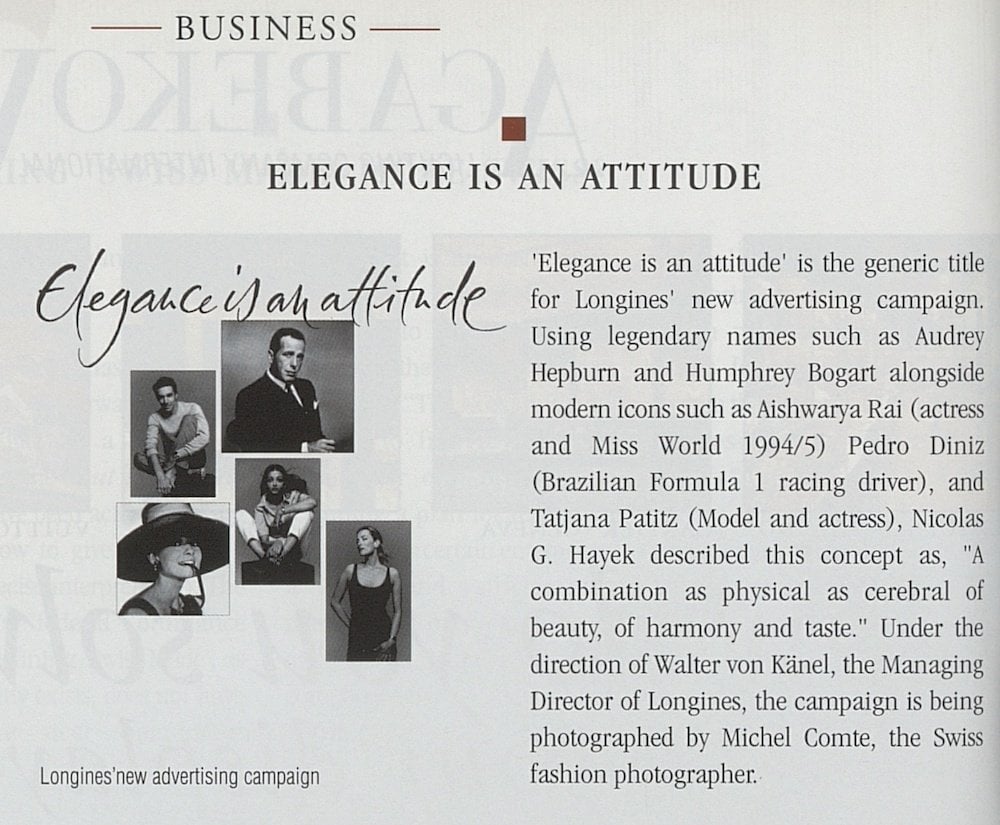
“Elegance is an attitude.” Longines’ iconic campaign was launched in 1999 under the supervision of Walter von Känel. ©Europa Star 1999
To fulfil his mission, the other part of the equation was to identify an aesthetic message adapted to Longines’ output at the dawn of the 2000s, which would see a complete explosion of graphic codes. For the Saint-Imier brand, this message would be the somewhat contrarian reaffirmation of a style that could stand the test of time and fashion: elegance.
In 1999, the “Elegance is an attitude” campaign was launched (see extract from our archive, above), around timeless figures such as Humphrey Bogart and Audrey Hepburn. Ambassadors would represent the different nuances of elegance: sporty, with Steffi Graf or Andre Agassi; cinematic, with Aishwarya Rai, Kate Winslet or Simon Baker.
The campaign is still running today.
-

- Longines’ Conquest VHP has recently been updated. Under Walter von Känel, a hands-on leader, everything was a matter of industrial continuity rather than radical disruption.
- ©Europa Star 4/1988
This “strategy of elegance” is what Walter von Känel described in another interview from 2001 (see below, full text available on our digital platform). Prior to this campaign, which made it possible to unify the brand’s communication, “Longines used to have a whole series of special production and distribution contracts that authorised various ‘national’ product releases. As a result, there was a dilution of the message and a dispersion of the image of the brand. We have worked to gradually eliminate these ‘national productions’ but it has taken some time,” he explained in the interview, in which he also emphasised the notion of “consistency”.
-

- The “strategy of elegance”: on the Chinese market in particular (an early conquest for the brand), Longines has become a giant in its field, that of the timeless Swiss watch without the stratospheric prices. When some competitors insisted on entering Haute Horlogerie in the 2000s, Longines declined to follow. In the meantime, many have doubled back.
- ©Europa Star, 2/2001
With the technical and aesthetic equations thus defined, Longines has been able to develop a coherent strategy over the last two decades. The brand has benefited greatly from its early establishment in China, a nation that Walter von Känel visited personally several times each year to nurture the relationships that are key to the success of any business in the country.
“We’ve been present in China for a century and a half,” he explained. “It’s a significant market for us and one that’s still growing. To balance our markets, we have to make more effort to promote and distribute our watches in Europe and the United States. But they’re very competitive markets.”
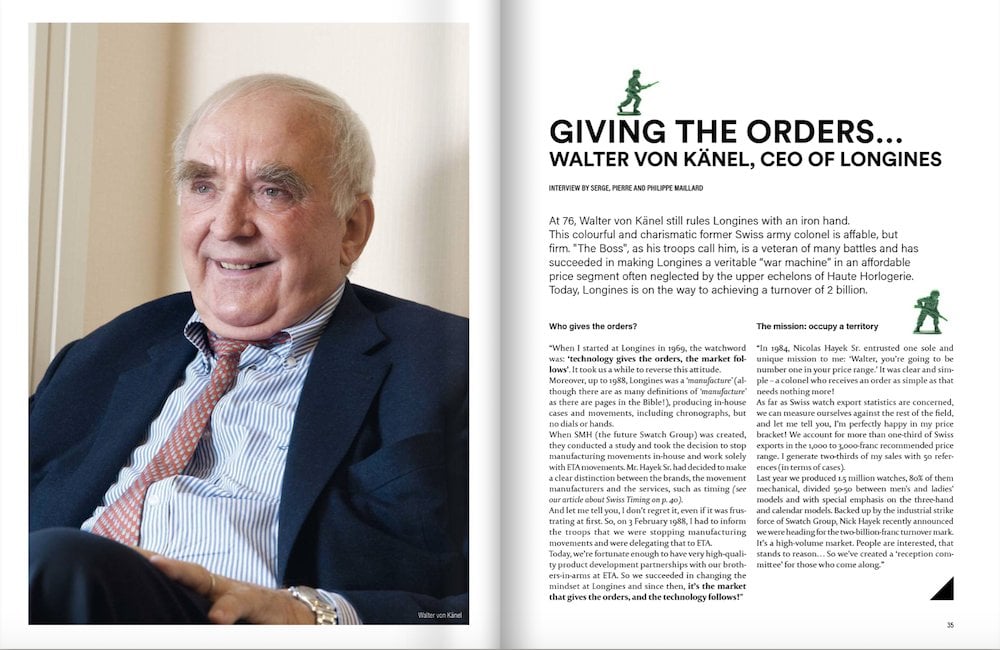
An interview with Walter von Känel in Europa Star in 2018, making abundant use of military metaphors. @Europa Star 2/2018
From 1 July onwards, this will be one of the major challenges facing Walter von Känel’s successor at Longines, Matthias Brechan, who has hitherto been at the helm of Rado. He will have to manage a new situation in which, following the outbreak of the coronavirus pandemic, intercontinental travel will be completely disrupted, particularly for Chinese customers. The aim will be not only to accompany the transfer of purchasing decisions from international markets to the Chinese domestic market, where the brand can already rely on a solid territorial foothold, but also to reduce dependence on Chinese customers in general. In short, the emphasis will be on working even more locally!
To achieve this, Walter von Känel had the gift of forging extremely strong interpersonal relationships. A true man of the field, a stranger to the technocratic digressions that kill off emotion (at a time when emotion has become the most important added value of watchmaking), he remains Honorary President of Longines and President of the Longines Foundation.
“His stature and common sense will be sorely missed. Captains of industry like him are rarely produced by business schools!”
What he did for Longines and for the industry will remain engraved in the history of Swiss watchmaking. His stature and common sense will be sorely missed... Because captains of industry of his stamp are rarely produced by business schools!
François Thiébaud: managing Tissot for 24 years
The musical chairs at the Swatch Group don’t stop there: since Matthias Breschan is replacing Walter von Känel at Longines, he himself will be replaced at Rado by Adrian Bosshard, the current CEO of Certina and Union Glashütte... who in turn will be replaced by Marc Aellen (VP sales of Jaquet Droz) at Certina and Franz Linder (current CEO of Mido) at Union Glashütte. In addition, Raynald Aeschlimann, President and CEO of Omega, has been appointed to the Executive Group Management Board.
This reshuffle above all marks the departure from the day-to-day operational scene of another “rock” of the Swiss watch industry: François Thiébaud of Tissot, who deserves an equally glowing tribute. If he hands over the title of CEO of the brand to Sylvain Dolla, he remains Chairman of the Board of Directors.
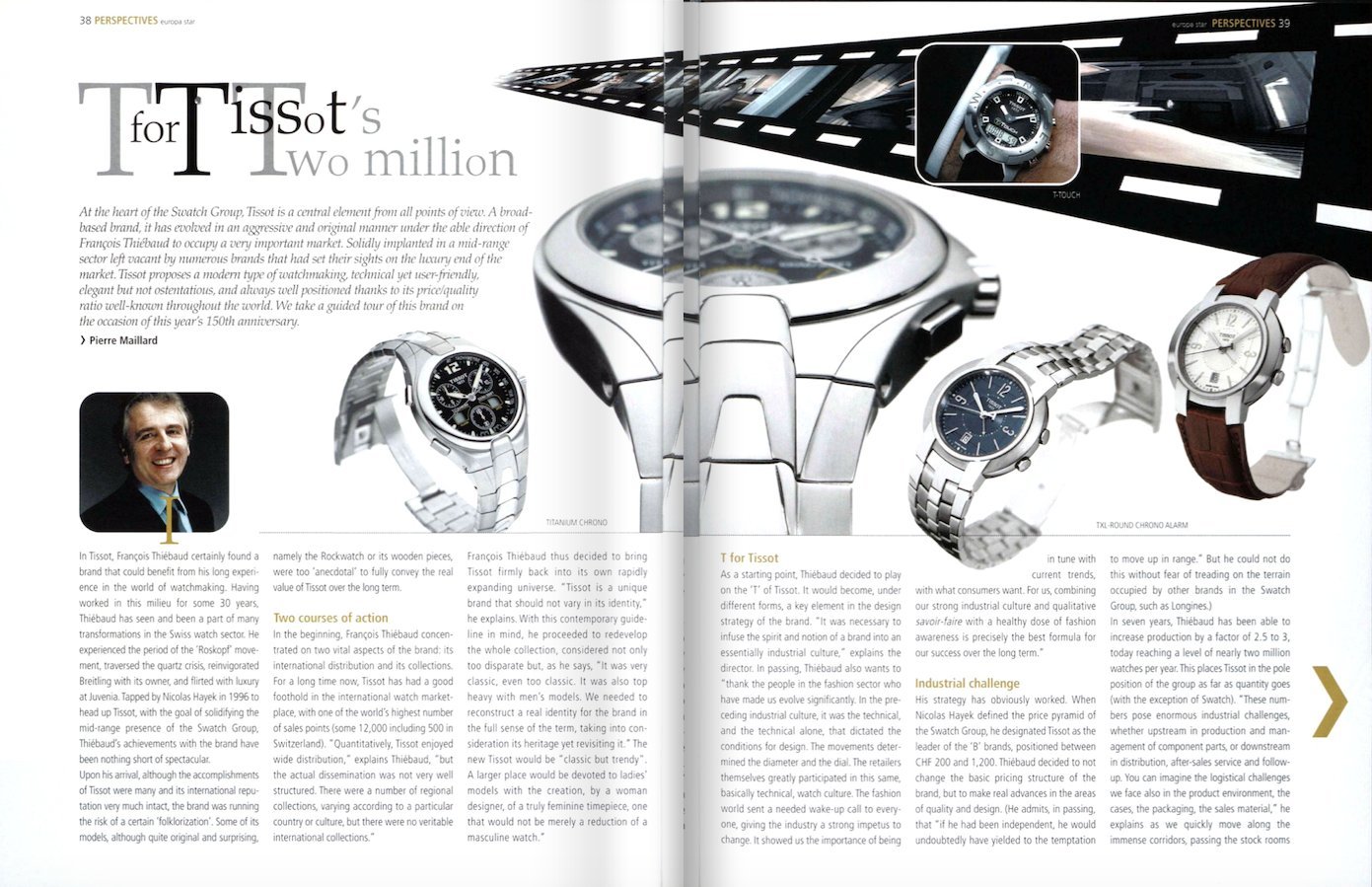
Interview with François Thiébaud published in Europa Star in 2003, detailing the changes that had taken place at Tissot since his arrival seven years earlier. @Europa Star 1/2003
In 1996, François Thiébaud was recruited by Nicolas Hayek to manage Tissot. In a portrait written in our columns in 2003 on the occasion of the brand’s 150th anniversary, we took stock with him of the actions taken up to then to transform the Le Locle-based watchmaker. It is fascinating to observe the parallels between his comments and those of Walter von Känel at Longines: “In the preceding industrial culture, it was the technical, and the technical alone, that dictated the conditions for design,” he told us. “For us, combining our strong industrial culture and qualitative savoir-faire with a healthy dose of fashion awareness was precisely the best formula for our success over the long term.”
The aim was to prepare the brand for an era of “triumphant” globalisation. François Thiébaud carried out two major operations to achieve this goal: on the one hand, restructuring distribution, to bring more quality and consistency to the already huge network of retailers (12,000 points of sale at the time of that interview); and on the other, restructuring the collections – fewer but more universal lines, that were more contemporary, with more women’s collections.
“The aim was to prepare the brand for an era of ‘triumphant’ globalisation. François Thiébaud carried out two major operations to achieve this goal.”
The objective: to occupy an area of accessible Swiss watchmaking that was also being increasingly deserted by the competition, lured away by the sirens of luxury – with the help of the Swatch Group’s industrial might, and also the obstinacy of Tissot’s manager.
In the same article, we introduced François Thiébaud in the following terms: “Having worked in the world of watchmaking for some 30 years, Thiébaud has seen and been a part of many transformations in the Swiss watch sector. He experienced the period of the Roskopf movement, traversed the quartz crisis, reinvigorated Breitling along with its owner, and flirted with luxury at Juvenia.”
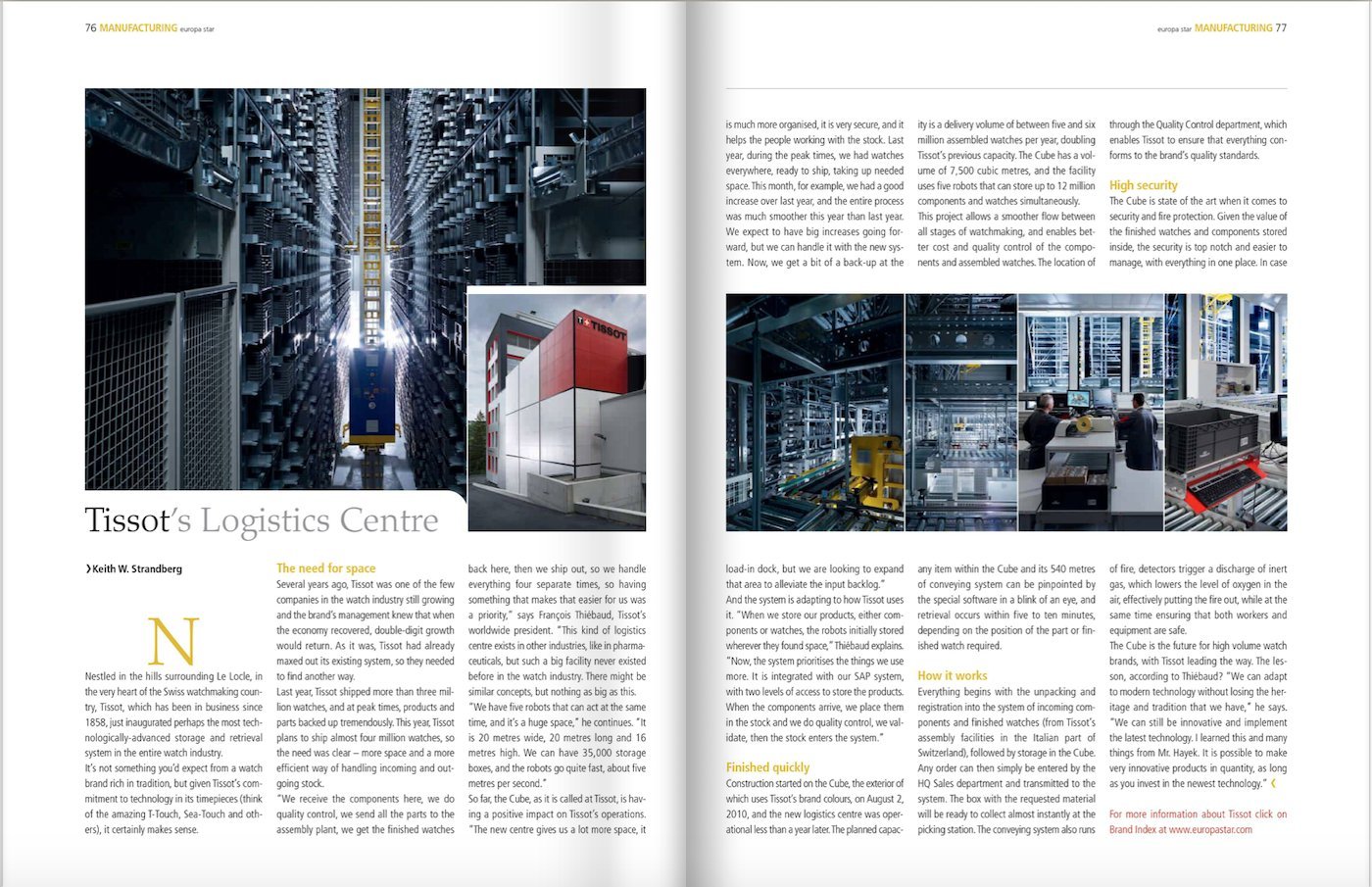
The Cube, a huge avant-garde logistics centre inaugurated by Tissot. ©Europa Star 6/2011
In 2011 we reported from the heart of the Cube, the new logistics centre built in Le Locle by Tissot, which in that year announced its intention to export some 4 million watches. Robotisation was under way, under the supervision of François Thiébaud, who explained to us during a visit to the premises: “This kind of logistics centre exists in other industries, such as pharmaceuticals, but never before in the watch industry.”
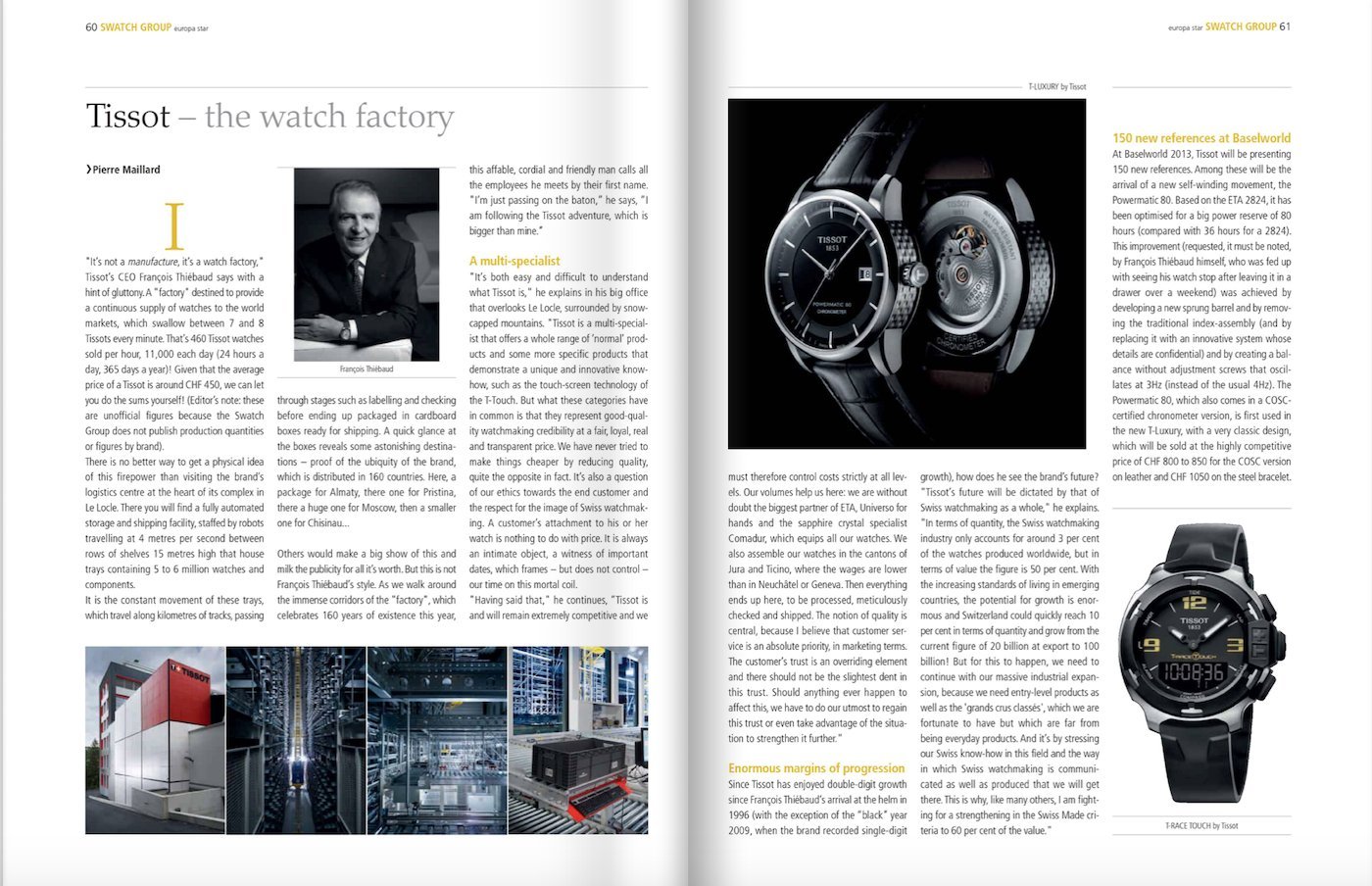
The T-Touch, a touch-screen sports watch that has become an emblem of the brand since the year 2000. ©Europa Star 2/2013
“Tissot is not a manufacture, it is a watch factory,” François Thiébaud repeated two years later, echoing Walter von Känel’s no-nonsense style. In this interview, we covered in more detail the T-Touch, the touch-screen sports watch that has become an emblem of the brand since the year 2000. “I’m just carrying the baton,” he confided to us. “I’m just a stage in the Tissot adventure, which is much bigger than my own.”
“Tissot is not a manufacture, it’s a watch factory.”
-

- François Thiébaud’s invigorating optimism. For us, Baselworld would not have been complete without an interview with the boss of Tissot.
- ©Europa Star 2/2014
Innovation, technology, confidence in progress in general: this is what we came to expect from François Thiébaud, every year at the Basel fair. Tissot was producing 840,000 units when Thiébaud arrived in 1996; now, it was producing four million. Above all, the manager understood that, in order to be strong, the Swiss watchmaking “pyramid” had to be able to produce a more accessible offering, the result of industrial innovation, alongside its luxury output. “Omega would not be where it is today if Swatch or Tissot hadn’t been around,” he told us.
“Omega would not be where it is today if Swatch or Tissot hadn’t been around.”
-

- The smartwatch posed a new challenge in the brand’s own playing field. The digital transition will be a hot topic for Tissot’s new manager, Sylvain Dolla.
- ©Europa Star 6/2014
The greatest challenge, however, lay ahead, with the emergence of a new product category in the under-CHF 1,000 segment: smartwatches. As early as 2014, in parallel with the launch of the Apple Watch, we were speculating on “the Swiss response”, which would naturally have to come through Tissot (see above). Perhaps we expected developments a little too early... Tissot’s connected watch, the T-Touch Connect Solar, finally came out only a few months ago, in the midst of the pandemic crisis.
“I’m just carrying the baton. I’m just a stage in the Tissot adventure, which is much bigger than my own.”
The digital revolution, which goes far beyond the issue of smartwatches alone, will be one of the hot topics awaiting François Thiébaud’s successor at Tissot, Sylvain Dolla, who was directly involved in the launch of the T-Touch Connect Solar and has considerable experience in the field. Formerly of Alcatel, he was head of High Tech & Access at Swatch before joining Hamilton, where he has just relaunched the first ever digital watch, the Hamilton Pulsar. Vivian Stauffer, head of sales at Hamilton, will take over the helm following Sylvain Dolla’s transfer to Tissot.
-

- The Rock Watch by Tissot, a timepiece that caught the imagination of American customers.
- @Europa Star 1/2017
We will end this homage with two archive pieces, reflecting the road travelled at Tissot. Above, the brand’s famous Rock Watch from the cover of one of our 1986 issues. In the midst of the quartz crisis, this audacious model gave the brand a new lease of life, particularly in the United States. In 2006, which saw a vast marketing offensive launched in the United States (where Tissot now sponsors the NBA), François Thiébaud declared: “Americans remember the Rock Watch, not Tissot!”
The other, much more recent extract (below) looks at the high-tech laboratories producing the Swissmatic calibre, a symbol of the technological edge that brought the brand into the age of robotics.
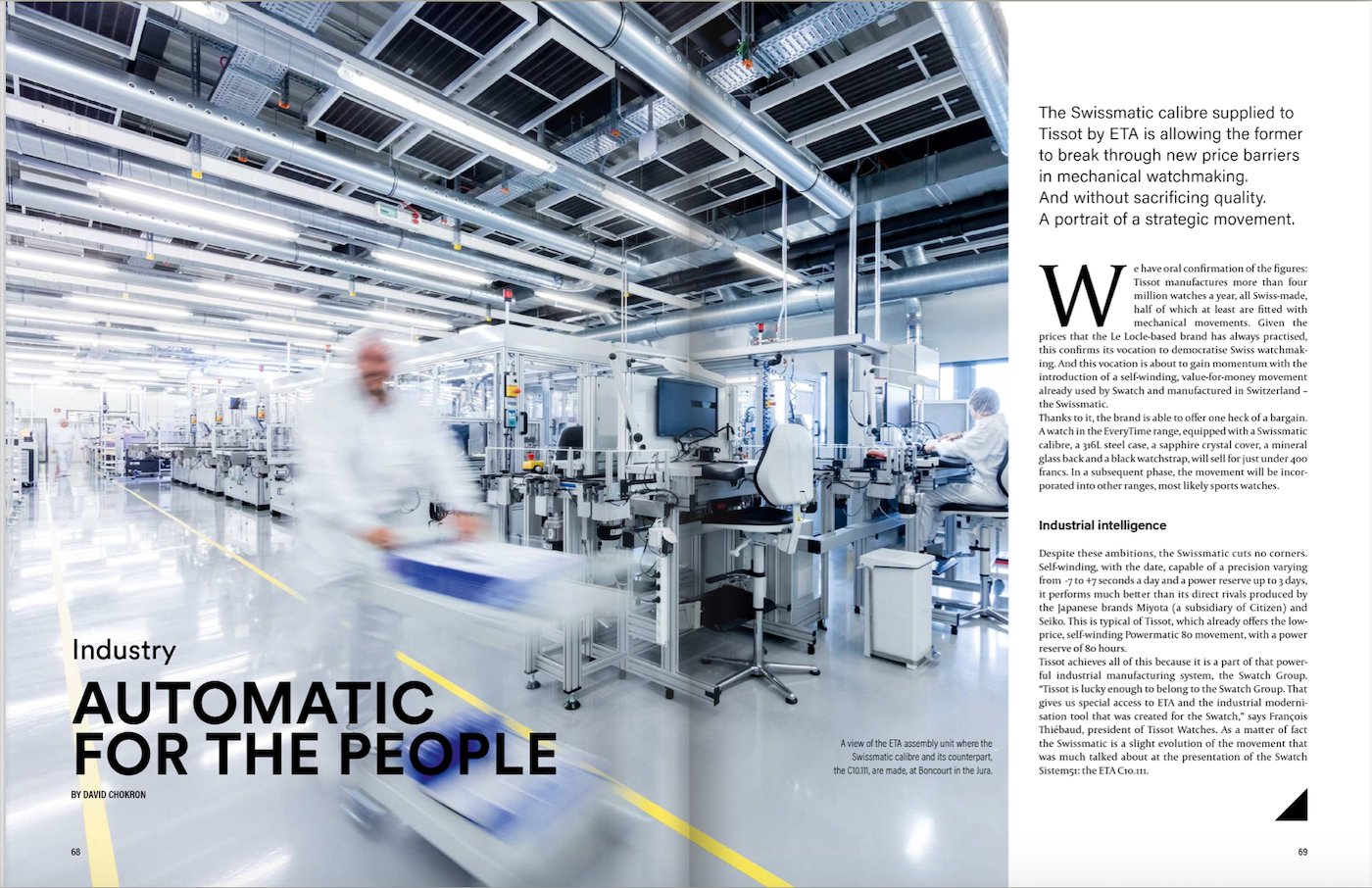
Swissmatic: the collaboration between ETA and Tissot is a cornerstone of the Swatch Group’s industrial apparatus. ©Europa Star 4/2017
At a time when volumes in the Swiss watch industry are falling drastically, when the pandemic crisis is threatening to erase all points of reference, and when hopes of a rebound are still unconfirmed, it will no doubt be necessary once again, in the coming months and years, to reinvent Swiss watchmaking.
This will be neither the first nor the last time, as Walter von Känel and François Thiébaud know only too well.
























































